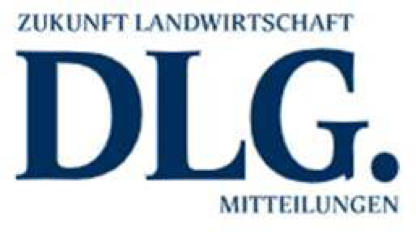
How precise are the predictions?
Source: DLG Mitteilung March 2021 – Research from University Kiel, Ketel Christian Prahl
Saving crop protection products without sacrificing yields - usually you only know after the harvest what the optimal expenditure would have been.
How well a fungicide strategy in wheat can be planned with prediction models has been investigated by Ketel Christian Prahl.
The use of crop protection products is of high interest for the public and often a central point of criticism in agricultural practice. A dialogue began between the critics and users in 2008, which resulted in the "National Action Plan" (NAP) which has been edited in 2013.
Most of the targets, e.g., lowering the maximum residue levels in all product lines under 1%, or the reduction of risks of the application of crop protection products, have been fulfilled. Targets to support the optimization of crop protection procedures, with reduced application in the integrated crop production have been mostly fulfilled but have improvement potential.
Optimization of crop protection procedures
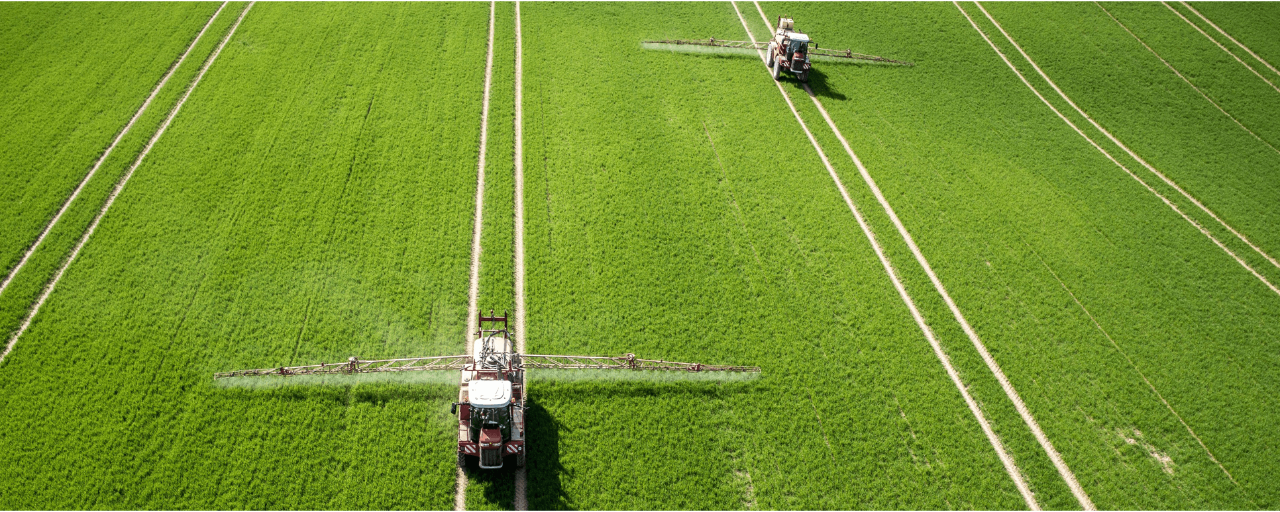
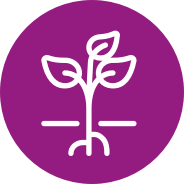
Around 89% of the crop protection applications are necessary measures and overline with the findings of the Julius Kühn-Instituts (JKI) and the NAP guideline.
But with a differentiated view on the active ingredient groups of herbicides, fungicides, and insecticides, which make up to 90% inland sales.
However, it is also clear that the JKI does not consider herbicides, where around 6% of the active ingredient quantities are used incorrectly, to be inappropriate. Rather, it is the fungicides and insecticides for which about 13% and 30% of the active ingredient quantities used are incorrectly applied. Considering the shares of the active ingredient groups in total domestic sales (herbicides: 53%, fungicides: 33%, insecticides: 3%), fungicides offer the greatest potential for optimization.
To further improve fungicide application, decision support tools are available to growers. By adapting applications to the epidemiology of the pathogens, incorrect applications can be minimized without significantly reducing yields. However, selecting an appropriate decision support tool is difficult for many farms. While a large number have been published, very few take pathogen complexes into account. There is also uncertainty in the selection of a suitable decision support tool, as this is not itself subject to any controls by independent institutions.
Therefore, in Schleswig-Holstein, field trials have been conducted in 2019 and 2020 to investigate the decision support capabilities of the IPS model wheat, the ISIP system, and the xarvio FIELD MANAGER, in terms of pathogen infestation, target indication, applicability, effectiveness and yield. The comparison took place on the one hand between the decision support tools and on the other hand to an untreated potato variant and a fully treated control. (fourfold application according to BBCH stages) took place.
In the process, possible inputs of parameters of the trial stocks into the decision support tools were continuously directly recorded on site. Independently of this, uniform exact carbonite analyses were carried out for the evaluation at weekly intervals for 3 all variants. The following were analyzed the growth development (BBCH stage) of the leaf apparatus, - the degree of necrotization, - the infestation intensity in the stand (MB), and - the infestation frequency in the stand (BHW).
For supra-regional testing, trial fields were established at several locations in Schleswig-Holstein with the variety Ritmo and the variety RGT Reform. The highly sensitive variety Ritmo, an increased occurrence of pests is to be expected, which allows a better differentiation of the strengths and weaknesses of the decision support tools with regards to pest suppression.
With the integration of the modern variety RGT Reform into the trial setup, the practicality of the decision support tools can be demonstrated at the same time. In order to be able to compare the use of fungicides, the treatment of the stands in all varieties was carried out according to a plan defined before the start of the trial, in which application rates and preparations were defined for all indications.
In the trial area, an epidemiological occurrence of the pathogen of Septoria leaf drought could be observed supra-regionally in the varieties Ritmo and RGT Reform. This was also true for the pathogens, relevant to Schleswig-Holstein, brown and yellow rust and for powdery mildew. In 2019, 94% of the application recommendations were directed against the pathogen causing Septoria leaf drought and 2% each against brown rust, yellow rust and powdery mildew. A similar distribution was also seen in 2020. Here, 90% of the application recommendations were directed against Septoria leaf drought and 5% each against the pathogens of brown rust and powdery mildew.
Due to the broad spectrum of activity of the fungicides used, the wheat was protected from possible infection by the pathogen causing powdery mildew and brown rust by the applications with indication against Septoria leaf drought. These were not included in the calculation. For pest control, the decision-making tools recommended an average of 2.5 applications in both varieties per location and variety in both trial years.
Intensity can be reduced without significant yield loses.
In 2019, the decision-making tools IPS Wheat Model and ISIP system each issued 2.8 application recommendations and the xarvio FIELD MANAGER issued 2 treatments. In 2020, the ISIP system recommended 2.7 treatments per site. The xarvio FIELD MANAGER and the IPS
Wheat Model, on the other hand, recommended only 2 treatments per site in the same period.
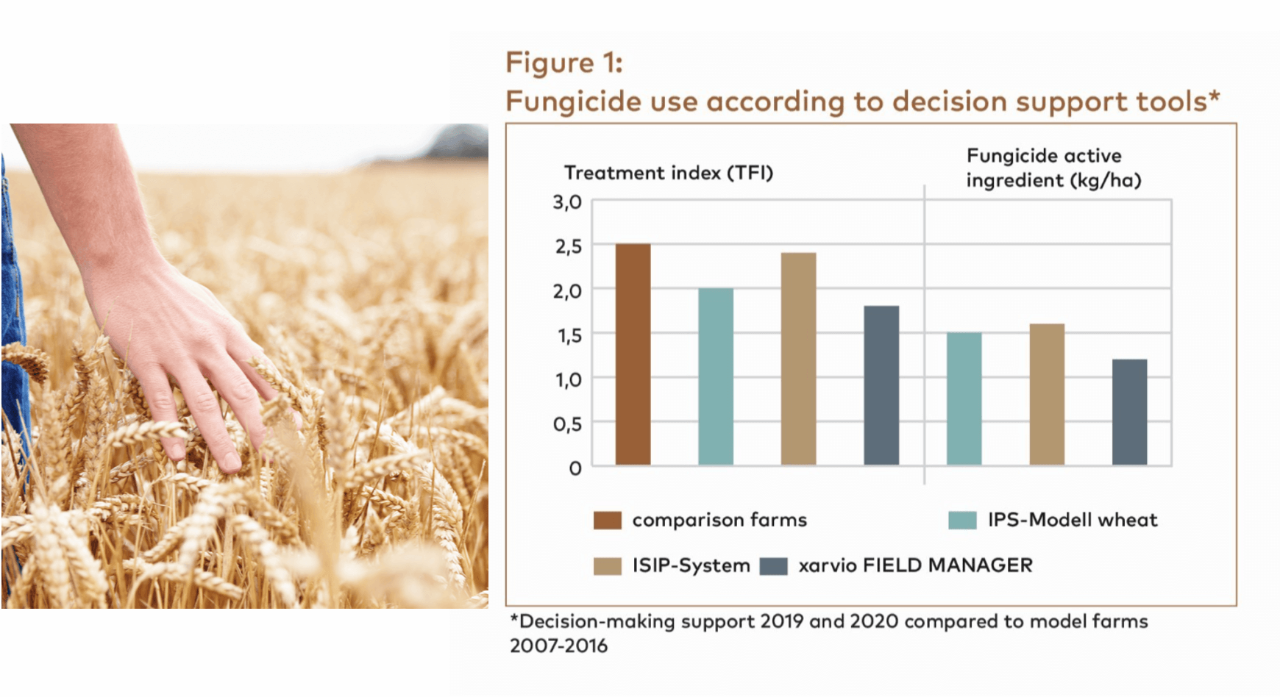
Whether the fungicide applications have been further optimised by the decision-making tools can be seen from a treatment index (TFI). This is a measure of treatment intensity and is calculated from the sum of the proportion of all fungicides used in relation to their maximum permitted application rate in a treatment period. If, for example, 3 fungicide applications are carried out at a site with 75% of the maximum permitted application rate in one year, a TFI of 3 x 0.75 = 2.25 is calculated. Preparations in tank mixtures are included individually in the calculation.
To classify the TFI of the decision support tools, the average TFI from the JKI studies of the years 2007 to 2016 was taken as a reference point. The network comparison farms achieved a TFI of 2.5, of which 87% of the fungicide applications corresponded to the so-called "necessary measure" according to JKI studies. In the trial years 2019 and 2020, a TFI of 2.1 and 2, respectively, was achieved on average across all decision support tools, with the IPS model wheat achieving a TFI of 2, the ISIP system a TFI of 2.3, and the xarvio FIELD MANAGER a TFI of 1.8. By reducing the treatment intensity, the amount of active ingredient used at the sites could be further reduced. On average, only 1.56 kg of fungicide active ingredient/ha was applied in the wheat IPS model, 1.61 kg/ha in the ISIP system and 1.22 kg/ha in the xarvio FIELD MANAGER in the decision support tools variants (Figure 2).
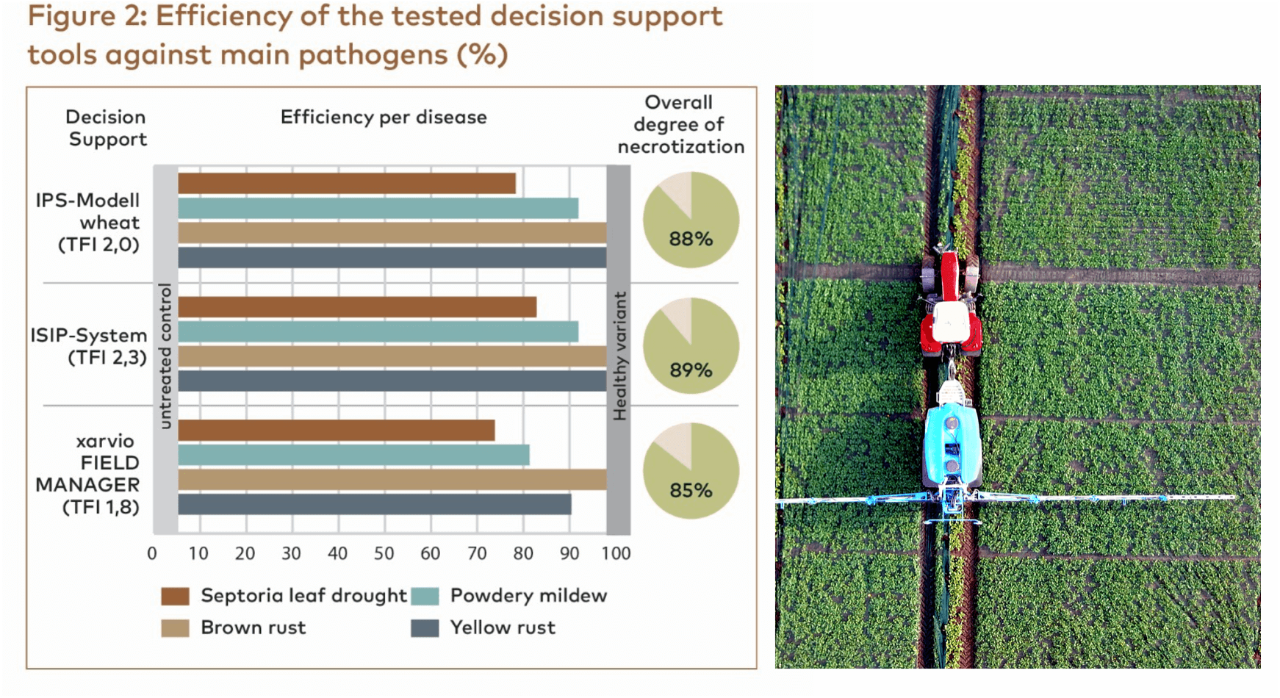
How effective is the fungicide with help of the decision support tools against pathogen infestation? In order to evaluate this, the infestation intensity in the the variants of the decision support tools have been looked at between the untreated control (0%) and the Fully treated control (100%) on the upper three leaf levels (flag leaf to F-2) at BBCH 77 (Figure 2). If a variant achieved an efficiency of 100%, the pathogens would be suppressed to the same extent as in the Fully treated control; 0% efficiency, on the other hand, represented an infestation equivalent to the untreated control.
The wheat IPS model achieved an overall efficiency of 93%, the ISIP system achieved 94%, and the xarvio FIELD MANAGER achieved an overall efficiency of 86% over the Fully treated control. This was true when considering infestation levels in the stand of Septoria leaf drought, P striiformis, P recondita and B. graminis. When looking individually at the main pathogen, Septoria leaf drought, the wheat IPS model was able to achieve an efficiency of 77%, the ISIP system one of 83%, and the xarvio FIELD MANAGER one of 74%. The degree of necrotization combines abiotic and biotic factors and is thereby an indicator of crop vigor. Looking at the decision support tools, the efficiencies here were 88% for the wheat IPS model, 89% for the ISIP system, and 85% for the xarvio FIELD MANAGER in both varieties and both years. Grain yield, in addition to the effect on the main pests, is a decisive evaluation criterion for the decision
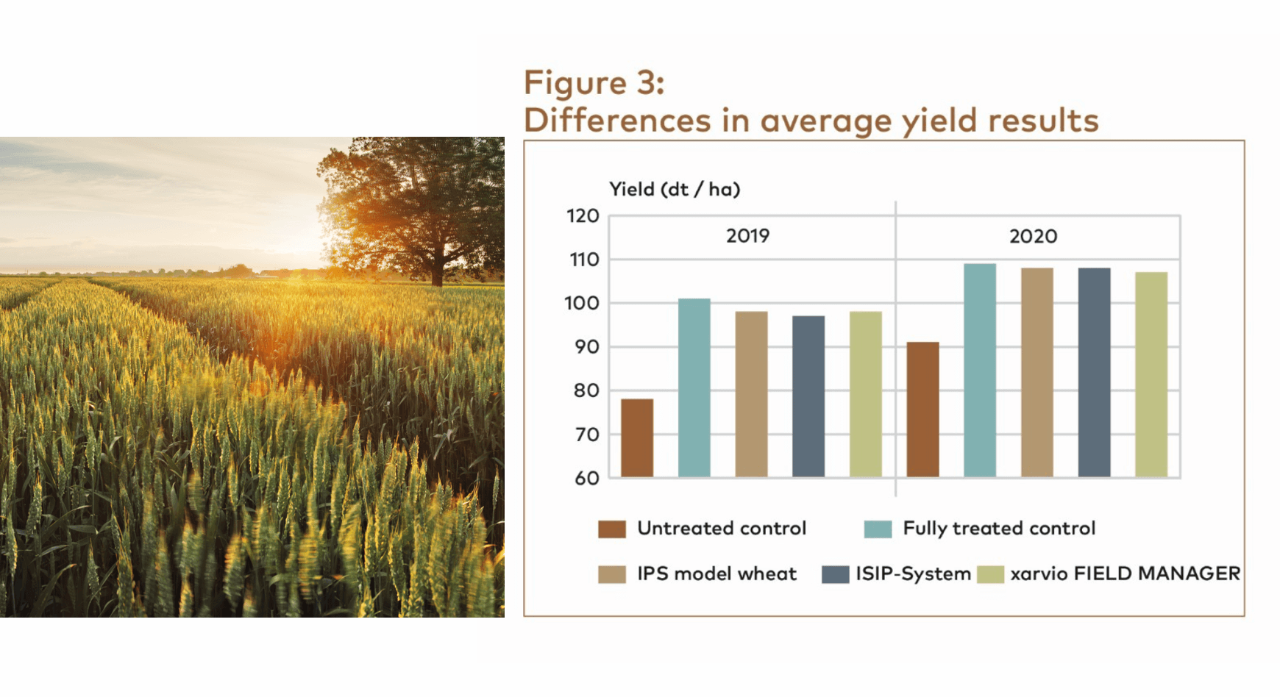
All decision support tools variants and the Fully treated control showed a significantly increased yield compared to the untreated control.
Furthermore, a statistical "non-inferiority" of the yields of the variants of all decision support tools compared to the Fully treated control could also be demonstrated, which means that the yield level of the Fully treated control could be reached by all decision support tools. On average, the Ritmo variety harvested 78.2 dt/ha in the untreated control and 100.2 dt/ha in the Fully treated control. Although the IPS wheat model with 97.5 dt/ha, the ISIP system with 96.8 dt/ha and xarvio FIELD MANAGER with 98.0 dt/ha ranked between these two controls, they showed no statistical difference to the Fully treated control. In the RGT Reform variety, higher yields were achieved overall in comparison to Ritmo. Yields averaged 92.8 dt/ha for the untreated control and 107.1 dt/ha for the Fully treated control. The decision support tools variants ranked with 105.7 dt/ha in the IPS model wheat, 105.3 dt/ha in the ISIP system, and 105.7 dt/ha in the untreated control.
And 103.9 dt/ha for the xarvio FIELD MANAGER also differed between the controls. Again, there was no statistical difference to the Fully treated control. As a consequence, differences in the efficiency on pathogen infestation between the decision support tools has been found. One possible reason for the differences in efficiency could be a different assessment of the importance of the leaf layers. For example, the xarvio FIELD MANAGER was found to differ from the other decision support tools, especially in the evaluation of the third uppermost leaf. This is because a reduction in the number of leaf layers evaluated in the infestation from the top three to the top two leaf layers showed an increase in efficiency of over 11%. In contrast, the IPS model wheat and ISIP system decision support tools demonstrated only a smaller increase in efficiency of 6% and 5%, respectively. This can also be seen in the initial application of xarvio FIELD MANAGER, which was recommended a later date than the IPS model wheat and the ISIP system at all sites in both 2019 and 2020.
Conclusion

In the two years of the experiment, all decision-making tools were able to achieve and prove a good result, so that the use of decision-making tool for the use of fungicides in wheat cultivation is a good opportunity for farms to use fungicides even more efficiently without having to dispense yield.
An important factor for the acceptance of decision support tools in practice is the amount of work farms must
associate with their use. Here it was shown that all decision support tools can be operated with a fundamentally very little effort, but there were differences in use between the decision support tools.
All recommendations can only be viewed in the IPS model wheat without prior login or registration, i.e. barrier-free. With the ISIP system, a notification and registration must be made for the Septoria leaf drought forecast, with all other pathogens this is not necessary.
With the xarvio FIELD MANAGER, you must always log in and register, and this is the only decision support tools that is subject to a fee.
In contrast, there are the personalization options: the adaptation of the decision support tools to the company using it is possible in great detail by entering operating parameters in the xarvio FIELD MANAGER, with the ISP system this is only the case with the Septoria leaf drought prediction and with the IPS model wheat the data must be entered again each time it is retrieved.





 Argentina (español)
Argentina (español)  Brazil (Portuguese)
Brazil (Portuguese)  Canada (English)
Canada (English)  France (Français)
France (Français)  Germany (Deutsch)
Germany (Deutsch)  Japan (Japanese)
Japan (Japanese)  USA (English)
USA (English)  Ukraine (Ukrainian)
Ukraine (Ukrainian)